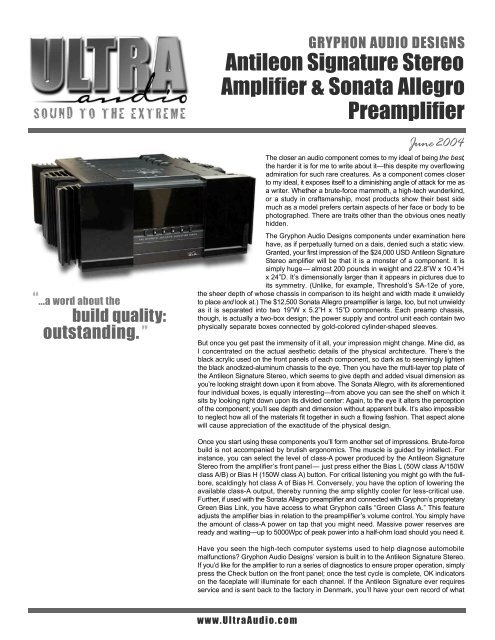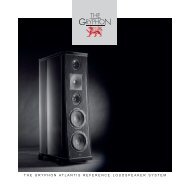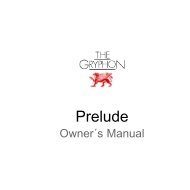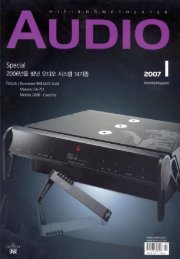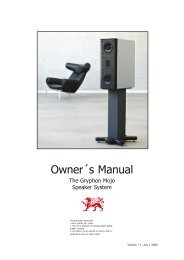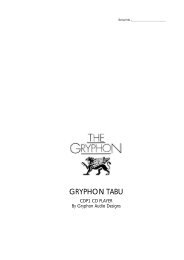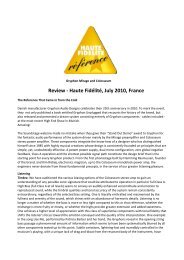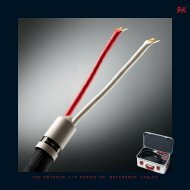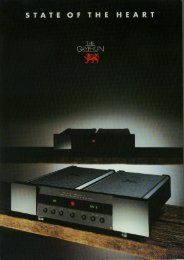Antileon Signature Stereo & Sonata Allegro Country
Antileon Signature Stereo & Sonata Allegro Country
Antileon Signature Stereo & Sonata Allegro Country
Create successful ePaper yourself
Turn your PDF publications into a flip-book with our unique Google optimized e-Paper software.
GRYPHON AUDIO DESIGNS<br />
<strong>Antileon</strong> <strong>Signature</strong> <strong>Stereo</strong><br />
Amplifier & <strong>Sonata</strong> <strong>Allegro</strong><br />
Preamplifier<br />
“...a word about the<br />
build quality :<br />
o u t s t a n d i n g . ”<br />
June 2004<br />
The closer an audio component comes to my ideal of being the best,<br />
the harder it is for me to write about it—this despite my overflowing<br />
admiration for such rare creatures. As a component comes closer<br />
to my ideal, it exposes itself to a diminishing angle of attack for me as<br />
a writer. Whether a brute-force mammoth, a high-tech wunderkind,<br />
or a study in craftsmanship, most products show their best side<br />
much as a model prefers certain aspects of her face or body to be<br />
photographed. There are traits other than the obvious ones neatly<br />
hidden.<br />
The Gryphon Audio Designs components under examination here<br />
have, as if perpetually turned on a dais, denied such a static view.<br />
Granted, your first impression of the $24,000 USD <strong>Antileon</strong> <strong>Signature</strong><br />
<strong>Stereo</strong> amplifier will be that it is a monster of a component. It is<br />
simply huge— almost 200 pounds in weight and 22.8”W x 10.4”H<br />
x 24”D. It’s dimensionally larger than it appears in pictures due to<br />
its symmetry. (Unlike, for example, Threshold’s SA-12e of yore,<br />
the sheer depth of whose chassis in comparison to its height and width made it unwieldy<br />
to place a n d look at.) The $12,500 <strong>Sonata</strong> <strong>Allegro</strong> preamplifier is large, too, but not unwieldy<br />
as it is separated into two 19”W x 5.2”H x 15”D components. Each preamp chassis,<br />
though, is actually a two-box design; the power supply and control unit each contain two<br />
physically separate boxes connected by gold-colored cylinder-shaped sleeves.<br />
But once you get past the immensity of it all, your impression might change. Mine did, as<br />
I concentrated on the actual aesthetic details of the physical architecture. There’s the<br />
black acrylic used on the front panels of each component, so dark as to seemingly lighten<br />
the black anodized-aluminum chassis to the eye. Then you have the multi-layer top plate of<br />
the <strong>Antileon</strong> <strong>Signature</strong> <strong>Stereo</strong>, which seems to give depth and added visual dimension as<br />
you’re looking straight down upon it from above. The <strong>Sonata</strong> <strong>Allegro</strong>, with its aforementioned<br />
four individual boxes, is equally interesting—from above you can see the shelf on which it<br />
sits by looking right down upon its divided center: Again, to the eye it alters the perception<br />
of the component; you’ll see depth and dimension without apparent bulk. It’s also impossible<br />
to neglect how all of the materials fit together in such a flowing fashion. That aspect alone<br />
will cause appreciation of the exactitude of the physical design.<br />
Once you start using these components you’ll form another set of impressions. Brute-force<br />
build is not accompanied by brutish ergonomics. The muscle is guided by intellect. For<br />
instance, you can select the level of class-A power produced by the <strong>Antileon</strong> <strong>Signature</strong><br />
<strong>Stereo</strong> from the amplifier’s front panel— just press either the Bias L (50W class A/150W<br />
class A/B) or Bias H (150W class A) button. For critical listening you might go with the fullbore,<br />
scaldingly hot class A of Bias H. Conversely, you have the option of lowering the<br />
available class-A output, thereby running the amp slightly cooler for less-critical use.<br />
Fu r t h e r, if used with the <strong>Sonata</strong> <strong>Allegro</strong> preamplifier and connected with Gryphon’s proprietary<br />
Green Bias Link, you have access to what Gryphon calls “Green Class A.” This feature<br />
adjusts the amplifier bias in relation to the preamplifier’s volume control. You simply have<br />
the amount of class-A power on tap that you might need. Massive power reserves are<br />
ready and waiting—up to 5000Wpc of peak power into a half-ohm load should you need it.<br />
Have you seen the high-tech computer systems used to help diagnose automobile<br />
malfunctions? Gryphon Audio Designs’ version is built in to the <strong>Antileon</strong> <strong>Signature</strong> <strong>Stereo</strong>.<br />
If you’d like for the amplifier to run a series of diagnostics to ensure proper operation, simply<br />
press the Check button on the front panel; once the test cycle is complete, OK indicators<br />
on the faceplate will illuminate for each channel. If the <strong>Antileon</strong> <strong>Signature</strong> ever requires<br />
service and is sent back to the factory in Denmark, you’ll have your own record of what<br />
w w w . U l t r a A u d i o . c o m
P 2<br />
GRYPHON AUDIO DESIGNS<br />
<strong>Antileon</strong> <strong>Signature</strong> <strong>Stereo</strong><br />
Amplifier & <strong>Sonata</strong> <strong>Allegro</strong><br />
Preamplifier<br />
“The Gryphons displayed all of<br />
t h e s e<br />
characteristics<br />
with a<br />
c o n f i d e n t<br />
s t r a i g h t f o rward character<br />
easily<br />
meeting my initial<br />
high expectations. ”<br />
was done inside the amplifier. An internal service log is contained within the upgradeable<br />
m i c r o p r o c e s s o r’s software, so you, or the subsequent owner (if you ever part with the amp!),<br />
will know if that particular unit was repaired or upgraded. Pretty advanced stuff going on in<br />
Scandinavia, I‘d say.<br />
But there is still that o u t w a r d appearance of simplicity that you’ll appreciate. For example,<br />
there are a variety of custom adjustments available to the user of the <strong>Sonata</strong> A l l e g r o<br />
p r e a m p l i f i e r, but the front panel isn’t cluttered with them. Instead, they’re hidden from sight<br />
behind the dark acrylic faceplate. You’ll only know they’re there by calling them up—<br />
either by the remote or from the front panel— at which time a menu will appear in red<br />
lettering behind the jet-black face; adjustments include level matching for each input, a<br />
default start-up level, and a maximum level so that a miscue doesn’t blow up your speakers.<br />
I was impressed. Just as the physical design reveals layers of well-thought-out detail, so does<br />
the user interface. There just always seems to be more to discover about these components.<br />
Before I describe the sound, here are the rest of the nuts’n’bolts. Both the <strong>Antileon</strong> <strong>Signature</strong><br />
<strong>Stereo</strong> and <strong>Sonata</strong> <strong>Allegro</strong> share a number of design characteristics, such as fully discrete,<br />
pure-class-A, dual-mono, fully balanced circuitry. The dual-mono aspect of the design of<br />
each component is taken to the practical extreme—there are two detachable power cords<br />
and two power switches for both the preamp and amp. The <strong>Antileon</strong> <strong>Signature</strong> <strong>Stereo</strong> is<br />
said to use “zero global feedback,” while the <strong>Sonata</strong> <strong>Allegro</strong> eschews “negative feedback.”<br />
Both components have massive capacitor banks for their respective functions. The amplifier<br />
sports twin-tiered banks totaling 440,000 microfarads, while the preamp counters with<br />
33,000 of its own. Internal wiring is kept to an absolute minimum in both units, and where<br />
it is needed Gryphon’s own Guideline Reference gold-embedded silver wire is used.<br />
The <strong>Antileon</strong> <strong>Signature</strong> <strong>Stereo</strong>’s mammoth weight is partly due to the custom-designed<br />
1500W transformers that are potted in epoxy and mounted inside their own shielded<br />
compartment. The <strong>Sonata</strong> <strong>Allegro</strong> utilizes custom-made C-core transformers— one for<br />
each channel—each mounted in a separate chassis. The 150Wpc <strong>Antileon</strong> <strong>Signature</strong> has<br />
balanced inputs only, but Gryphon does supply a set of high-quality RCA-to-XLR adapters.<br />
Two sets of rugged gold-plated binding posts of Gryphon’s own design are provided for<br />
biwiring. The <strong>Sonata</strong> <strong>Allegro</strong> has four balanced XLR and two single-ended RCA inputs<br />
and two balanced and one single-ended output. The multiple outputs make powering<br />
subwoofers and/or multiple amplifiers a snap. The <strong>Sonata</strong> <strong>Allegro</strong>, according to the design<br />
brief included with the unit, even has its very own power-line conditioning and voltage<br />
regulation.<br />
Finally, a word about the build quality: outstanding. I have long admired companies that<br />
go above and beyond to deliver a product that is constructed with greater care than most.<br />
It’s one aspect of my Wilson Audio loudspeakers that is obvious before you even hear<br />
them. The Gryphon separates are similarly impressive. Every chassis component is fitted<br />
to the next with precision, while each piece is machined with excruciatingly tight tolerances.<br />
Sheer perfection. Onlookers in your listening room might question why you paid so much<br />
for a Gryphon component, but they won’t question that what they’re looking at is top-shelf<br />
stuff. During the audition period even casual observers in my home commented on the<br />
incredible aesthetic design of the Gryphon gear.<br />
But all of these details would be for naught if it weren’t for the equally impressive sound.<br />
Once the Gryphon Audio Designs tandem was powering and controlling my system, the<br />
sonic attributes of the components revealed themselves in much the same way as the<br />
physical and ergonomic design elements—in stages. The first impression was predictable.<br />
I expect big solid-state electronics to have lots of drive, deep bass, and an immensely<br />
dynamic presentation. The Gryphons displayed all of these characteristics with a confident,<br />
straightforward character, easily meeting my initial high expectations.<br />
w w w . U l t r a A u d i o . c o m
P. 3<br />
GRYPHON AUDIO DESIGNS<br />
<strong>Antileon</strong> <strong>Signature</strong> <strong>Stereo</strong><br />
Amplifier & <strong>Sonata</strong> <strong>Allegro</strong><br />
Preamplifier<br />
One of my recent musical references, Mickey Hart and the Kodo<br />
drummers performing “Daraijin” from Mondo Head [SACD, Sony/<br />
Red Ink 56111], provides ample opportunity for electronics to fall apart<br />
or shine, especially when driving large speakers capable of deep,<br />
impactful bass and crisp transient snap. The Wilson Alexandria X-2s<br />
were kept under tight-fisted control on this track, starting and stopping<br />
with agility. The deep bass whacks were centered and visceral, and<br />
as physically experienced as I’ve heard over TWBAS. The musical<br />
presentation sounded confident and fully rendered as the bass<br />
rolled through my room in waves—it was clear that lots of refined<br />
power was on tap. This also resulted in a completely stable and<br />
refined soundstage.<br />
“It is the<br />
completeness<br />
of their<br />
p e rf o r m a n c e<br />
that leads to<br />
the magic<br />
of their sound. ”<br />
However, running through some favorite discs, I discovered there<br />
was much more to the Gryphon presentation than what is typically<br />
expected with expensive solid-state electronics. There was a tonally<br />
rich presence; a full palette of colors was available to make the music<br />
sound real, in this case just the opposite of washed out and thin.<br />
Listen to Siberian-born Konstantin Scherbakov performing Rachmoninov’s Piano Concertos<br />
No.2 and No.3 [DVD-Audio, Naxos 5.110013] with the Russian State Symphony Orchestra<br />
and you might wonder just what type of amplifying component you’re hearing; the positive<br />
characteristics that are typically attributed to tube electronics simply ooze from these<br />
bipolar beasts. Piano had appropriate weight and body, the studio acoustic was delivered<br />
with dimensional accuracy, and scale was not a problem. It was almost as if I were<br />
biamping my speakers with a solid-state behemoth on the bass end and a tonally pleasing<br />
tube amp up top. Such was the best-of-both-worlds sound I was experiencing.<br />
Perhaps the most impressive aspect of the Gryphon Audio Designs combo was the palpable<br />
yet huge soundstage that developed in my room. The Wilson X-2 Alexandrias are, in my<br />
experience, without peer in their ability to cast a soundstage that’s as believable as I can<br />
imagine. The Gryphon separates were able to exploit this capability fully, even beyond<br />
what I’d heard with previous amplifiers. Images were locked in place from wall to wall,<br />
though not possessed with razor-sharp edges; instead they were more lifelike than hi-fi,<br />
being full of body and dimensionally accurate at the same time. A fine example of this<br />
characteristic could be heard when playing back Holst’s The Planets as performed by the<br />
Royal Scottish National Orchestra (SACD [Naxos 6.110004]). The r e a l n e s s factor was<br />
incredibly high on “Mars, the Bringer of Wa r,” and as it must have sounded when originally<br />
recorded in the City Halls of Glasgow, Scotland.<br />
Finally I must say that, although it’s hard to objectively quantify, the elusive emotional<br />
connection with some of my favorite tunes grew by important margins. Eva Cassidy’s<br />
soulful performance of Sting’s “Field’s of Gold” (Live at Blues Alley [Blix Street 10046])<br />
is heart-wrenching over any system, but it reached new depths of emotion as played<br />
through the Gryphon electronics. It was the clincher, the point at which I knew I was hearing<br />
audio electronics that bettered anything I had previously heard.<br />
Always do right. This will gratify some people and astonish the rest.<br />
In many ways the <strong>Antileon</strong> <strong>Signature</strong> <strong>Stereo</strong>/<strong>Sonata</strong> <strong>Allegro</strong> duo combines the most-soughtafter<br />
qualities of the best electronics I’ve heard: the extension and control of the Halcro<br />
dm68 along with the purity of tone and natural presentation of the Lamm M1.2 Reference<br />
amps. It’s not that they walk a fine line between those two extremes of design, but rather<br />
tread both sides of the line seemingly at the same time. Perhaps the Gryphon separates<br />
are not quite as tomb-like quiet as the Halcros, and I could argue that the Lamms’ m u s i c al<br />
cohesiveness is second to none in my experience, but the Gryphon combo put together<br />
w w w . U l t r a A u d i o . c o m
P. 4<br />
GRYPHON AUDIO DESIGNS<br />
<strong>Antileon</strong> <strong>Signature</strong> <strong>Stereo</strong><br />
Amplifier & <strong>Sonata</strong> <strong>Allegro</strong><br />
Preamplifier<br />
Gryphon Audio Designs<br />
Industrivej 9<br />
8680 Ry<br />
Denmark<br />
Phone: (45) 86891200<br />
Fax: (45) 86891277<br />
E-mail: sales@gryphon-audio.dk<br />
Website: www.gryphon-audio.dk<br />
a set of strengths that I once thought were diametrically opposed. It is the completeness<br />
of their performance that leads to the magic of their sound.<br />
Which leaves the inevitable question— what is best? At this exalted level, there are no<br />
losers. For The Wo r l d ’s Best Audio System I’m only seeking out gear that holds the highest<br />
promise, so therefore I could argue that a number of electronics that I’ve heard could be<br />
called b e s t. In the right system and to a particular listener, any of them could come out on<br />
top. But to leave it at that would be taking the easy way out.<br />
So perhaps the better question is this: If I had to quit auditioning amplifiers and preamplifiers<br />
today and keep one stereo setup for the duration of my days, which eletronics would I choose<br />
out of all those I’ve heard? The Gryphon Audio <strong>Antileon</strong> <strong>Signature</strong> <strong>Stereo</strong> amp and <strong>Sonata</strong><br />
<strong>Allegro</strong> preamp, without a second thought. They’re the desert-island pairing I’d most like<br />
to be stranded with. And if that happens, don’t come find me anytime soon.<br />
...Jeff Fritz<br />
jeff@ultraaudio.com<br />
w w w . U l t r a A u d i o . c o m


